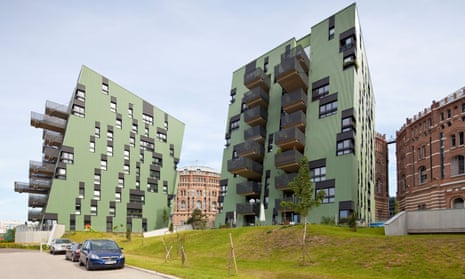Crisis is often the spur to social innovation, so surely there must be some evidence of it in housing? Innovation and big, bold ideas are required as much now as in the postwar years in Britain, when conditions across the country for too many were shockingly poor, even if their homes had not become rubble. In response, high-quality house building was delivered on an impressive scale.
While housing is a national crisis, the most pressing concerns differ from area to area. The lack of affordable homes being built every year is a huge issue, especially in London. But in the north, and elsewhere in the UK, there are empty houses in some areas with too few resources to bring them back to life. As professor Charles Egbu, dean of the School of Architecture at London South Bank University, said at a recent conference, the current crisis isn’t just about a lack of political will to invest in social housing.
It’s also about a huge skills shortage in construction; red tape and planning restrictions; a benefits and tax system that fails to invest in the provision of sustainable, affordable, high-quality homes and, in London, the impact of overseas investors.
Social innovation – across countries – is providing solutions, as the examples below demonstrate. If sufficient political will were added, such initiatives could be given what they lack now – investment and support so they can move up to a groundbreaking level.
COMMUNITY LAND TRUSTS
St Clement’s East London community land trust – the UK’s first urban community land trust, supported by the campaigning organisation, Citizens UK – will provide 23 new homes in June at a third of the open market “value” by linking the price of the home to local rent. A further 229 homes will be sold at market price to help fund the scheme. Owners must sell back to the trust if they wish to move. Citizens UK aims to have 5,000 community land trust homes by 2025. It wants a “presumption in favour of communities” on public land. The UK now has 200 CLTs, mostly in rural areas where farmers sell a few acres.
SELF-BUILD
In Almere Poort, the Netherlands, Labour politician Adri Duivesteijn popularised the idea of self-build because he wanted demand-driven, small-scale homes. Built on 250 acres of council land, the scheme provides plots for those on low incomes (£14,500 in 2015). Once a plot is acquired, the buyer can customise their home from a number of ready-made options. The scheme also offers plots for people on higher incomes. The aim is for Almere to eventually have 3,500 self-built homes. There are very few planning regulations. Landscaping and final road provision is only undertaken after the completion of all individual homes in each section. In the UK, the coalition government promised to “rip up regulations” and made provisions to support self-builds, but it is still a very small enterprise here.
EMPTY HOMES DOCTOR
Set up in Leeds in 2013, a team made up of solicitors, estate agents, roofers, decorators, social care workers and the local authority’s empty homes department work on empty homes. An initial social impact report says that the scheme, a free service subsidised by Leeds council, generated close to £350,000 of trade for local businesses, bringing 59 houses back into use. More than 100 have been renovated since it was set up.
MICRO BUILDING
Carmel Place, which has just been completed in New York, has 55 units – 250 sq ft (23 sq metres) to 370 sq ft, with high ceilings and built-in sofas, beds and storage. The units are made of steel slabs and concrete frames prefabricated off-site. The building has a gym, community room, roof terrace and storage lockers. Rent is about £600 a month for a number of affordable units, compared with local Manhattan rents of £2,200.
BATIGÈRE FOUNDATION HOUSING NETWORK, FRANCE
This network of social housing bodies in Metz engages proactively in the community to promote equal opportunities, economic development and “all actions fostering social ties”. It recognises that housing is part of a network of concerns.
THE VIENNA MODEL
In the Austrian capital, 25% of housing stock is social housing and a further 35% is limited-profit housing-association stock. Housing is seen as a human right. For social housing, you need a lower income initially but then secure tenancy for life, so there is no stigma attached, and one result is socially mixed communities. High-profile architects such as Norman Foster are enlisted for projects, and good design is nurtured. Subsidised rents are funded by taxes included a land tax; unused sites are taxed higher; and there’s strong protection of tenants’ rights.
CO-OPS
Co-operative and mutual housing bodies in the UK take diverse forms with the unifying factor being that the membership has democratic control of issues such as repairs, rents and who joins and leaves. A report in 2009 showed the highest levels of satisfaction for this type of housing but it makes up only 0.6% of housing here, compared with 18% in Sweden and 15% in Norway.
DE ROKADE SHELTERED HOUSING, THE NETHERLANDS
An apartment tower in Groningen aimed at “younger” older people, De Rokade offers several types of accommodation, including more than 200 daycare and nursing beds and a kindergarten. Rokade Tower – a private residential development – has an indoor “town square” and a cafe that encourages all generations and avoids the isolationist ghetto approach of many housing concepts for older people.
Many more examples of innovation can be seen in entrants to the World Habitat Awards run by the Building and Social Housing Foundation. Themes include resident involvement, flexibility in planning and lifting restrictions on local authorities so they can innovate and invest.
Underlying many notions is a sense that too often housing and land have been turned into lucrative investments disproportionate to the wages and incomes of most of the population. Instead, there needs to be a shift to providing housing for real communities.








Comments (…)
Sign in or create your Guardian account to join the discussion